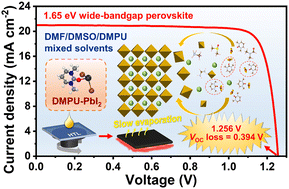Custom-tailored solvent engineering for efficient wide-bandgap perovskite solar cells with a wide processing window and low VOC losses†
Abstract
In perovskite solar cells (PSCs) with wide band gaps (∼1.65–1.68 eV), the poor quality of perovskite films due to uncontrolled fast crystallization significantly contributes to the loss in open-circuit voltage (VOC), thereby limiting the further enhancement of silicon/perovskite tandem solar cells (TSCs). To address this issue, we propose a custom-tailored solvent engineering strategy via partially replacing dimethyl sulfoxide (DMSO) with 1,3-dimethyl-3,4,5,6-tetrahydro-2(1H)-pyrimidinone (DMPU) for achieving high-quality perovskite films and efficient perovskite solar cells with a wide antisolvent processing window. Benefiting from the strong interaction between DMPU and PbI2, DMPU custom-tailored solvents effectively delay and regulate the crystallization and growth process of perovskite films, leading to larger grains and reduced defects. Furthermore, the formed stable DMPU–PbI2 intermediate phase can continuously release PbI2, weakening the influence of the antisolvent dripping time and thereby prolonging the processing window. Due to the improvement of the film quality by DMPU, the performance and stability of the as-prepared 1.65 eV PSCs have been significantly enhanced, delivering a champion power conversion efficiency (PCE) of 21.9% and an impressive VOC of 1.256 V. The VOC loss with respect to the band gap is only 0.394 V, which is one of the lowest loss values in the wide-bandgap (1.65–1.68 eV) PSCs used for silicon/perovskite TSCs.



 Please wait while we load your content...
Please wait while we load your content...